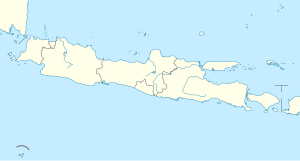Malang
| Malang | |||||||
|---|---|---|---|---|---|---|---|
| City | |||||||
Clockwise, from top left : Malang City Hall, Badut Temple, Gajayana Stadium, Malang Railway Station, Karangkates Dam
|
|||||||
|
|||||||
| Motto: Malang Kuçeçwara | |||||||
| Location of Malang in Indonesia | |||||||
| Coordinates: 7°58′48″S 112°37′12″E / 7.98000°S 112.62000°ECoordinates: 7°58′48″S 112°37′12″E / 7.98000°S 112.62000°E | |||||||
| Country |
|
||||||
| Province |
|
||||||
| Government | |||||||
| • Mayor | |||||||
| Area | |||||||
| • City | 145.28 km2 (56.09 sq mi) | ||||||
| • Metro | 2,156.6 km2 (832.7 sq mi) | ||||||
| Elevation | 476 m (1,562 ft) | ||||||
| Population (2010 Census) | |||||||
| • City | 820,243 (BPS, 2,010) | ||||||
| • Metro | 2,795,209 | ||||||
| • Metro density | 1,300/km2 (3,400/sq mi) | ||||||
| Time zone | WIB (UTC+7) | ||||||
| Area code(s) | +62 341 | ||||||
| Vehicle registration | N | ||||||
| Website | www |
||||||
Malang is the second largest city in East Java. It has a history dating back to the Singhasari. The city population at the 2010 Census was 820,243 (BPS, 2010). Its built-up (or metro) area was home to 2,795,209 inhabitants spread on 2 cities and 22 districts (21 in Malang Regency and 1 in Pasuruan Regency). During the period of Dutch colonization, it was a popular destination for European residents. The city is well known for its mild climate. People in East Java sometimes call it "Paris of East Java." In 2013, Malang was spared many of the effects of the Asian financial crisis, and since that time it has been marked by steady economic and population growth.
The etymology of the name Malang is uncertain. One of the theory said that the name Malang is derived from the words Malangkucecwara which means "God has destroyed the false and enforced the right". The words was taken from an ancient term which mention a legendary temple called Malangkucecwara supposedly located near the city Malang. The word Malangkucecwara was applied as the motto of the city of Malang.
The history of Malang Regency could be revealed through the Dinoyo inscription 760 AD as the primary official document to support the birth of Malang before a new inscription was discovered in 1986, which is so far not yet revealed. According to the inscription, it was concluded that the 8th century was the beginning of the existence of Malang Regency's government due to the birth of King Gajayana's ruling of his kingdom in Malang. From the Dinoyo inscriptions, it is noted that the inscription used the "Candra Sengkala" or "Cronogram" Calendar, and stated that the birth date of Malang Regency was on Jum'at Legi (sweet Friday) of 28 November 760 AD.
The city was capital city of Singhasari in 1222, then transferred to Dutch colony. Malang was modernized under the Dutch; its mild climate which results from its elevation, along with its proximity to the major port of Surabaya, made it a popular destination for the Dutch and other Europeans. In 1879, Malang was connected to Java's railroad network, further increasing development and leading to increased industrialization.
Along with growth came urbanization. The government could not satisfy the population’s needs for affordable housing, which led to the building of shanty towns along the rivers and rail tracks. Today, the shanty towns still exist; although some have been transformed into “better” housing.
...
Wikipedia







